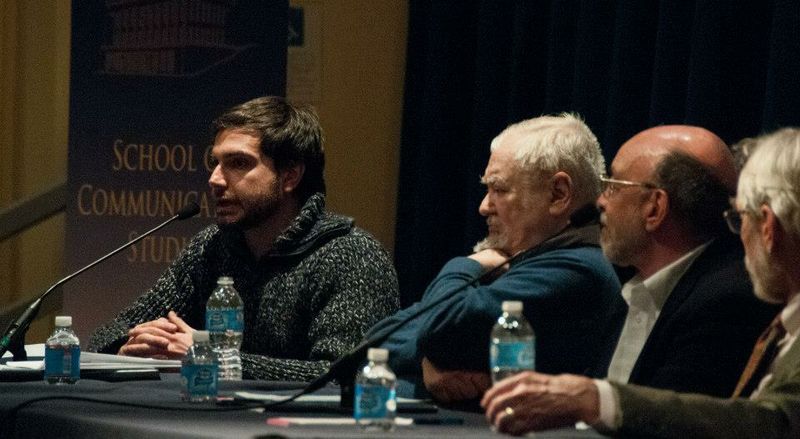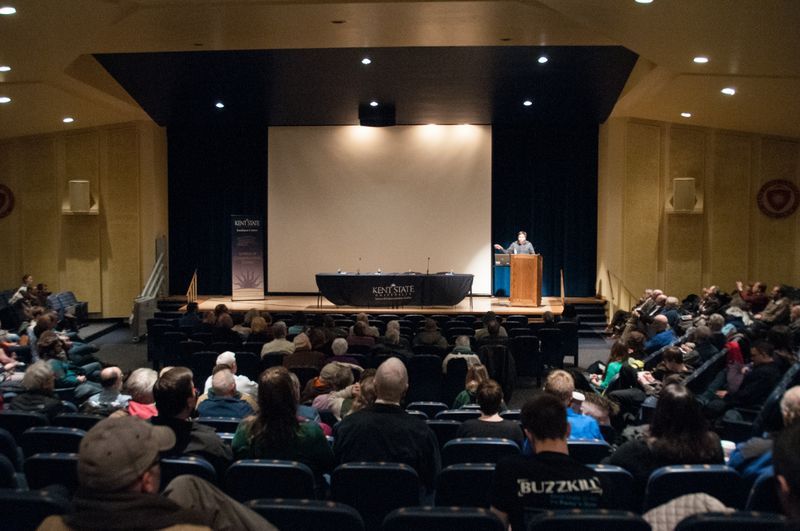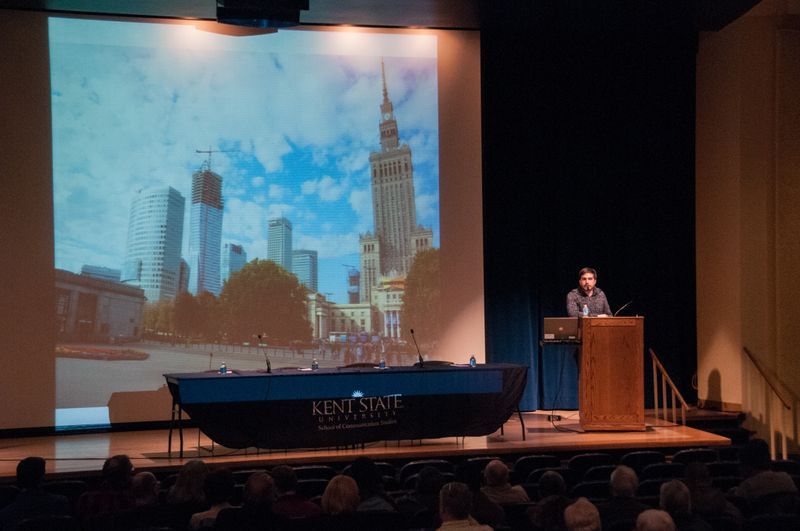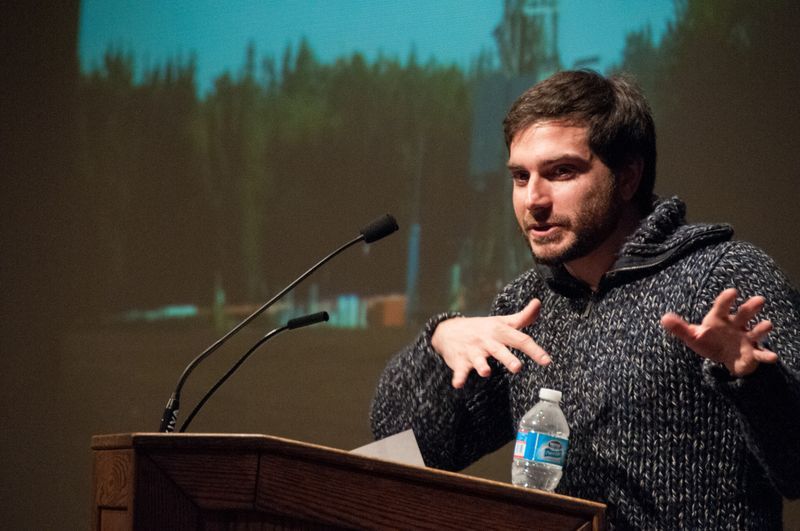The Pulitzer Center now has its very own “rock" star.
Grantee Dimiter Kenarov’s tempest of a U.S. tour in early 2013 encompassed more than a month of visits to universities and middle and high schools as well as various other appearances, including the inaugural session of Talks @ Pulitzer and at the World Affairs Council of Pittsburgh. Wrapping up his tour with an interview at Pulitzer Center offices, Dimiter jokingly dubbed himself a “sedimentary-rock star” – both a nod to shale gas, the subject of the project, and to the whirlwind nature of the trip.
Kenarov said some days he gave up to five lectures on the controversial subject of shale gas and its extraction by hydraulic fracturing, or fracking. He'd then add in being interviewed by students from college newspapers as well as local media including WKSU, NPR’s local station in Kent, Ohio; KQV-Pittsburgh; and WBEZ-Chicago. WBEZ coincidentally interviewed Al Gore about his new book soon afterward, and Worldview host Jerome McDonnell opened the fracking discussion with Gore by saying, “I was talking to a guy from Bulgaria about Polish fracking the other day.”
Kenarov, who indeed is from Bulgaria, decided to dig into the world of fracking during January 2012 protests in his home country against shale gas exploration. Approximately half of his Pulitzer Center project, “Shale Gas: From Poland to Pennsylvania,” consists of reporting from Poland, Eastern Europe's new center of shale gas extraction. During late January and most of February 2013, Dimiter traveled to 10 cities in six states: San Diego, Washington, Chicago, Pittsburgh, Philadelphia, Miami, Burlington,Vt. and Kent, Oberlin, and Columbus, Ohio, spending several days at each location talking about his reporting. He spoke to more than 2,330 people during those visits.
Kenarov appeared in a variety of contexts, sometimes lecturing solo but also sitting on several panels. The tour opened with a joint presentation with Pulitzer Center Education Director Mark Schulte at the WorldLink Youth Town Meeting, organized by the Joan B. Kroc Institute for Peace and Justice at the University of San Diego. Next, Kenarov presented with Calkins Media Vice President Stanley Ellis at the University of Chicago. Calkins Media, which publishes the Shale Reporter, supported Kenarov's reporting project along with the Pulitzer Center.
In Philadelphia and Pittsburgh, cities with close regional ties to the fracking issue, Kenarov undertook more than a dozen talks – at three universities, four high schools, a World Affairs Council breakfast and a media workshop as well as a radio interview. Then he returned to his alma mater, Middlebury College in Vermont, to speak to students there. A few days later, Kenarov and fellow Pulitzer Center grantee Mellissa Fung spoke at the University of Miami about the local costs of global extractive industries. Fung’s recent reporting took her to Panama to report on a Canadian gold mining project. From Miami Kenarov flew north again to Kent State University for a "Forum on Fracking” with other experts in the field, including Akron Beacon Journal environmental reporter Bob Downing and two Kent State geology professors. He continued across Ohio for an appearance at Oberlin College before wrapping up the fracking tour at Ohio University.
Kenarov’s project focused on reporting primarily from Pennsylvania and Poland, so the variety of audiences, opinions and locations on the tour intrigued him. He said he still cannot take a clear stance on the matter because it remains so complex, which is what he loves about this story and also what gives him the most trouble.
“It’s been very exhausting – everybody has a stake in this subject and wherever you go, people are just so polarized about it, and it’s very hard to be a journalist,” he said. “I had to tread very carefully and present both sides as objectively as possible. Within communities themselves people are split.”
Of all the places he visited, Chicago impressed Kenarov the most. On the campus of the University of Chicago he said he felt as though he was talking to experts in the field, not mere college students. In Pittsburgh and Philadelphia, which lie in close geographical proximity to shale gas extraction sites, “people were really just engaged on a very personal level,” said Kenarov. “They knew a lot about it; they had an opinion.”
Strong feedback followed his appearances. “I have heard resounding praise for you and your work from our faculty and students alike,” Kent State School of Visual Communication Design Marketing Coordinator Anne Dudley wrote in an e-mail to Kenarov. “I know our faculty members were impressed and grateful for your class visits, especially in the variety of information you were able to cover.”
But Kenarov, who admits he is not an expert in geology or economics, received perhaps his biggest compliment from a geology professor at the University of Pittsburgh, who remarked that the freelance journalist had certainly done his research.
“I was amazed at the different directions a seemingly technical subject like shale gas extraction can take,” wrote Schulte, who accompanied Kenarov throughout much of the trip. “Discussions about fracking can branch out into social, environmental and political spheres. And Dimiter's wide-ranging interests, even-handed view of the pros and cons, and impressive grasp of the global implications of the practice served him well.”
Kenarov’s visits were not free of criticism, however, due to the divisive nature of the issue. He explained that some anti-fracking environmentalists attacked him for not being “radical” enough. “I’m just covering this issue; it’s not my job to say I want to ban fracking,” he would respond. One audience member compared the practice of fracking to the Holocaust.
“I said, ‘well, that’s sort of specious,’” Kenarov recalled. “But people will make all kinds of comparisons like that.”
Upon his return to the Pulitzer Center offices in late February, Kenarov said he was ready to take a break from shale gas for “at least a year,” but he would consider more work on the subject eventually. First things first: “I need a haircut,” he said solemnly. “I look like a Lego man or something.”
Check out the following links to press coverage of and interviews with Dimiter Kenarov before and during his tour:
KentWired (online news website for Kent State Student Media)
Kent Patch announcement - Featured Flyer on homepage for one day
Kent State COMM studies news story
Ohio University online article
Video recording of "Fracking: Promise or Peril?" panel at Kent State University









